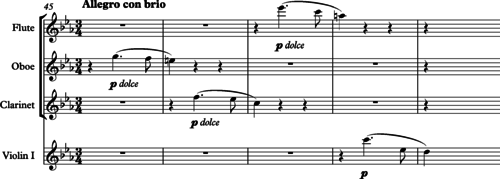Klangfarbenmelodie
Klangfarbenmelodie (German for sound-color melody) is a musical technique that involves splitting a musical line or melody between several instruments, rather than assigning it to just one instrument (or set of instruments), thereby adding color (timbre) and texture to the melodic line. The technique is sometimes compared to "pointillism",[1] a neo-impressionist painting technique.
The term derives from Arnold Schoenberg's Harmonielehre,[2] where he discusses the creation of "timbre structures." Schoenberg and Anton Webern are particularly noted for their use of the technique, Schoenberg most notably in the third of his Five Pieces for Orchestra (Op. 16), and Webern in his Op. 10 (likely a response to Schoenberg's Op. 16), his Concerto for Nine Instruments (Op. 24), the Op. 11 pieces for cello and piano, and his orchestration of the six-part ricercar from Bach's Musical Offering:
This may be compared with Bach's open score of the subject and the traditional homogeneous timbre used in arrangements:
Notable examples of such voice distribution that preceded the use of the term may be found in music of the 18th and 19th centuries. John Eliot Gardiner says of the orchestral opening of J.S. Bach’s Cantata Brich dem Hungrigen dein Brot, BWV 39, “Bach sets out almost tentatively in an introductory sinfonia with repeated quavers tossed from paired recorders to paired oboes to the strings and back over stiffly disjointed quavers in the continuo.”:[3]

In Beethoven's Symphony No. 3, ("Eroica"), first movement, according to George Grove, we hear "a succession of phrases of three notes, repeated by different instruments one after another":[4]

.
Similarly, in the fourth movement of Berlioz' Symphonie Fantastique, ("March to the Scaffold") , the melody first appears as a descending scale played on 'cellos and basses:

Later, this melodic line is passed between the strings and the winds several times:

There are further instances in the works of Claude Debussy.

Regarding the latter, Samson writes: "To a marked degree the music of Debussy elevates timbre to an unprecedented structural status; already in Prélude à l'après-midi d'un faune the color of flute and harp functions referentially."[5]
In the 1950s, the concept inspired a number of European composers including Karlheinz Stockhausen to attempt systematization of timbre along serial lines, especially in electronic music.[6]
See also
References
- ↑ Rogers 2004, p. 147; Swenson 1978, p. xv; Nadel 1999, p. 245; Hoffer 2009, p. 275.
- ↑ Schoenberg 1966, p. 503: Am Klang werden drei Eigenschaften erkannt: seine Höhe, Farbe und Stärke. [...] Die Bewertung der Klangfarbe, der zweiten Dimension des Tons, befindet sich also in einem noch viel unbebautern, ungeordetern Zustand [...]. Ist es nun möglich, aus Klangfarben, die sich der Höhen nach unterscheiden, Gebilde entstehen zu lassen, die wir Melodien nennen, Folgen, deren Zusammenhang eine gedankenänliche Wirkung hervorruft, dann muss es auch möglich sein, aus den Klangfarben der anderen Dimension, aus dem, was wir schlechtweg Klangfarben nennen, solche Folgen herzustellen, deren Beziehung untereinander mit einer Art Logik wirkt, ganz äquivalent jener Logik, die uns bei der Melodie der Klanghöhen genügt. ("In a musical sound (Klang) three characteristics are recognized: its pitch, color [timbre], and volume. [...] The evaluation of tone color (Klangfarbe), the second dimension of tone, is thus in a still much less cultivated, much less organized state [...]. Now, if it is possible to create patterns out of tone colors that are differentiated according to pitch, patterns we call 'melodies', progressions, whose coherence (Zusammenhang) evokes an effect analogous to thought processes, then it must also be possible to make such progressions out of the tone colors of the other dimension, out of that which we call simply 'tone color', progressions whose relations with one another work with a kind of logic entirely equivalent to that logic which satisfies us in the melody of pitches." English translation by Roy E. Carter in Schoenberg 1978, p. 421.)
- ↑ Gardiner 2014, p. 447.
- ↑ Grove 1898, p. 60.
- ↑ Samson 1977, p. 195.
- ↑ Rushton 2001
Sources
- Grove, George (1898). Beethoven and His Nine Symphonies. London: Novello. Reprinted, New York: Dover Publications, 1962.
- Hoffer, Charles (2009). Music Listening Today. . ISBN 9780495571995. ISBN 9780495916147.
- Nadel, Ira B., ed. (1999). The Cambridge Companion to Ezra Pound. Cambridge and New York: Cambridge University Press. ISBN 978-0-521-64920-9.
- Rogers, Michael R. (2004). Teaching Approaches in Music Theory: An Overview of Pedagogical Philosophies. . ISBN 9780809388790.
- Gardiner, John Eliot (2014). Music in the Castle of Heaven: A Portrait of Johann Sebastian Bach. London: Allen Lane.
- Rushton, Julian (2001). "Klangfarbenmelodie", The New Grove Dictionary of Music and Musicians, second edition, edited by Stanley Sadie and John Tyrrell. London: Macmillan Publishers.
- Samson, Jim (1977). Music in Transition: A Study of Tonal Expansion and Atonality, 1900–1920. New York: W. W. Norton & Company. ISBN 0-393-02193-9.
- Schoenberg, Arnold (1966). Harmonielehre (seventh ed.). Vienna: Universal-Edition. [First edition, Leipzig and Vienna: Verlagseigentum der Universal-Edition, 1911.]
- Schoenberg, Arnold (1978). Theory of Harmony. translated by Roy E. Carter. Berkeley and Los Angeles: University of California Press.
- Swenson, Milton, ed. (1978). Annibale Padovano, Cristofano Malvezzi, Jacopo Peri and Annibale Padovano: Ensemble Ricercars, A-R Editions. ISBN 9780895790897.
External links
- A streaming MP3 recording of Webern's orchestration of the Ricercar a 6 from Bach's Musical Offering.
- (French) Klangfarben Orchestra